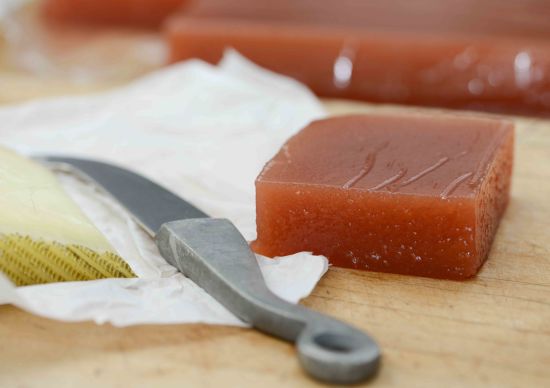
1 vanilla pod/bean
2 strips (1.5 x 5cms each) lemon peel (only the yellow peel, no white pith)
3 tablespoons lemon juice
about 4 cups of raw sugar, exact amount will be determined during cooking
Peel, core and roughly chop quinces. Place pieces in a large saucepan and cover with water. Add the vanilla pod/bean and lemon peel and bring to a boil. Reduce to a simmer, cover, and let cook until the quince pieces are tender (about 30 minutes).
Strain the water from the quince pieces. Discard the vanilla pod but keep the lemon peel with the quince. Process the quince pieces in a food processor. Make sure you process the lemon peel well as you don’t want to be biting into a piece of it.
Measure the quince purée. Whatever amount of quince purée you have, that’s how much sugar you will need. So if you have 4 cups of purée, you’ll need 4 cups of sugar. Return the quince purée to a large saucepan. Make sure it has a heavy bottom as otherwise the mixture will burn. Heat to medium to low. Add the sugar. Stir with a wooden spoon until the sugar has completely dissolved. Add the lemon juice.
Continue to cook over a low heat, stirring occasionally, for 1 ½ hours, until the quince paste is very thick and has a deep orange pink colour. It’s important you use a wooden spoon for stirring.
Preheat oven to a low 50°C. Line a 18 x 30cms baking pan with cooking paper and grease it with a thin coating of butter. Pour the cooked quince paste into the paper-lined baking pan, making sure you don’t scrape the bottom of the saucepan as inevitably a little will have caught there. Smooth out the top of the paste so it is even. Place in the oven for about 2 hours to dry it out. Remove from oven and let cool. Refrigerate.
It’s a labour of love this one, but you’ll be proud of your efforts. Best with Spanish Manchego cheese! Treat yourself!
Website designed by www.thecornerstorecollective.com
Developed by Richard Hpa